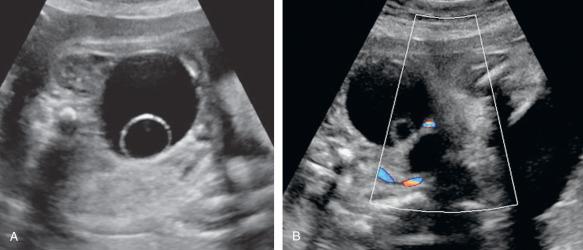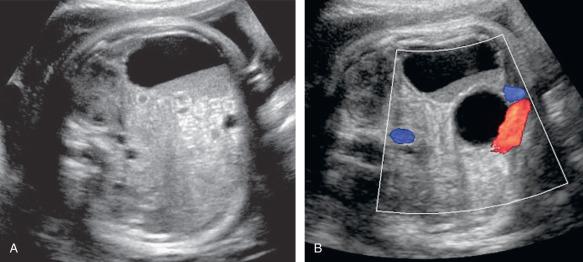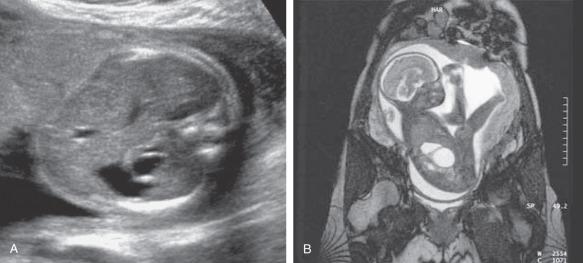Physical Address
304 North Cardinal St.
Dorchester Center, MA 02124
Different organ systems can give rise to abdominal cysts that can be detected on prenatal ultrasound (US) ( Table 24.1 ). Depending on the location, gestational age, gender, and US appearance of the cyst, a limited differential diagnosis or the correct diagnosis can often be achieved. Intraabdominal cysts may develop from many organs. The most frequent origins are the urinary system (hydronephrosis, multicystic dysplastic kidneys, polycystic kidneys, hydroureter, megacystis; see Chapter 12, Chapter 13, Chapter 14, Chapter 15, Chapter 16 ) or dilated bowel (see Chapter 26 ). Other origins of abdominal cysts include the biliary system (see Chapter 25 ), liver (see Chapter 28 ), and spleen (see Chapter 32 ). This chapter addresses ovarian cysts, enteric duplication cysts, mesenteric cysts/mesenteric lymphangioma, hydrocolpos, urachal cysts, and umbilical vein varix.
| Gastrointestinal tract | Dilated stomach, dilated proximal duodenum, dilated jejunum or ileum, dilated colon, meconium pseudocysts |
| Mesenteric cysts/lymphangioma, enteric duplication cysts | |
| Hepatic cysts, cystic hepatic tumors, biliary cysts | |
| Splenic cyst | |
| Urinary tract | Renal cysts, (macro-)cystic kidneys, multicystic-dysplastic kidneys, hydronephrosis, dilated upper pole in duplex kidney, dilated ureter, dilated bladder, ureterocele |
| Urachal cyst, persistent cloaca | |
| Genital | Ovarian cysts |
| Hydrocolpos, hydrometrocolpos | |
| Others | Umbilical vein varix |
Fetal abdominal cysts at 11–14 weeks are rare. In the majority of cases cysts are an isolated finding and 60% to 80% resolve spontaneously. In cases of persistence or when the cyst is not completely anechoic, close follow-up is recommended, because of the association with anorectal or other gastrointestinal malformations.
Ovarian cysts are fluid-filled sacs arising from the ovary.
After the kidneys and bowel, the ovaries are the third most frequent organ giving rise to abdominal cysts. The first case was reported by Valenti et al. in 1975. The incidence was initially estimated to be 1 : 2625 pregnancies. With improving image quality the number of cases diagnosed prenatally might have increased, but the incidence of 1 : 2500 is confirmed in more recent reports.
The fetal ovary is sensitive to the maternal gonadotropins. Fetal ovarian cysts are usually functional, mostly follicles enlarged as a result of stimulation by maternal and placental hormones. A higher prevalence of these cysts is noted in pregnancies complicated by diabetes, preeclampsia, and rhesus immunization, i.e., in pregnancies with an increased release of placental human chorionic gonadotropin.
Ovarian cysts are usually detected in the second or third trimester, mostly as incidental findings. Postnatal regression is common because of a lack of stimulating maternal hormones. Most ovarian cysts are unilateral.
The ultrasound (US) appearance depends on the size of the cyst and the possible complications, such as torsion of the ovary or intracystic bleeding. Uncomplicated cysts typically appear as a unilocular, thin-walled cystic mass ( Fig. 24.1 ). Ovarian cysts may appear as a complex mass (with internal echoes, septations, or debris; Fig. 24.2 ) or as a solid mass when complicated by torsion or internal bleeding.


Magnetic resonance imaging (MRI) is not required to diagnose ovarian cysts. An ovarian cyst can be an incidental finding on fetal MRI; in T2-weighted images it appears as a white cystic structure.
A simple intraabdominal cystic structure (2 to 5 cm) in a female fetus, typically unilateral, with normal urinary tract (kidneys and bladder clearly seen) and intestinal tract (no dilated bowel).
The US appearance of a fetal ovarian cyst may be indistinguishable from mesenteric or enteric duplication cysts. The identification of a male gender can help exclude ovarian cyst or hydrocolpos and to make persistent cloaca or megacystis-microcolon-intestinal hypoperistalsis syndrome (see Chapters 19 and 30 ) unlikely. Other considerations in both sexes include urachal cyst (located in the midline and above the bladder, in contact with the abdominal wall and not mobile), mesenteric cyst (generally multiloculated), and enteric duplication cyst (thicker wall owing to the presence of mucosa). A complicated ovarian cyst (torsion with thickened “wall”) can also imitate a meconium pseudocyst (see Chapter 26 ).
Options for prenatal management include observation and, in the case of a simple cyst, aspiration. The conservative approach is usually preferred. Authors favoring prenatal aspiration claim to prevent ovarian torsion and its complications (i.e., necrosis and intraabdominal inflammation). The procedure has to be weighed against the risk of complications (i.e., preterm rupture of membranes, infection, and bleeding). No randomized trial comparing invasive and conservative approaches exists. Periodic follow-up to check the size and appearance of the cyst can be recommended. A puncture with aspiration of the cyst may be reasonable for very large cysts likely to impair vaginal delivery. Otherwise fetal ovarian cysts do not present a contraindication for vaginal delivery.
Postnatal US confirms the diagnosis. Other imaging modalities (MRI or computed tomography [CT]) are usually not required. Depending on the size and the appearance of the cyst, the choice is between conservative and invasive management. A recent metaanalysis including 34 studies with a total of 954 fetuses showed that 54.6% (95% confidence interval [CI] 47.0–62.0) of the cysts regressed either during pregnancy or after birth. Resolution occurred significantly less often in complex versus simple cysts (odds ratio [OR]: 0.15, 95% CI 0.10–0.23) and in cysts ≥ 40 mm compared to smaller ones (OR: 0.03, 95% CI 0.01–0.06). An observed change in ultrasound pattern on follow-up examination was associated with an increased risk of eventual ovarian loss (positive predictive value [PP]: 57.7%, 95% CI 42.9–71.8). The risk of ovarian torsion was also significantly higher in cysts ≥ 40 mm (OR: 30.8, 95% CI 8.6–110). Larger and complex cysts tended to have surgery more often. In cases with prenatal aspiration 38% recurred (95% CI 14.8–64.3), torsion and hemorrhage (diagnosed after birth) complicated 10.8% (95% CI 4.4–19.7), and 9.7% (95% CI 3.7–18.3), respectively. Eighteen percent of fetuses undergoing prenatal aspiration also had surgery after birth.
In the neonate it seems reasonable to operate (laparoscopically, if possible) on cysts larger than 40 mm, or complex and symptomatic cysta. Cystectomy is preferred over oophorectomy. Large simple ovarian cysts in neonates can also be aspirated under US guidance. Smaller cysts and simple cysts are often managed conservatively. Accompanying videos show a laparoscopic marsupialization of a simple ovarian cyst in a neonate ( ) and a laparoscopic retrieval of a spontaneously detached ovarian cyst ( ).
Enteric duplications comprise two layers of epithelium and share the vascular supply with the adjacent intestinal tract. They are typically in immediate contact, but not in continuity, with the intestinal tract.
Enteric duplication cysts are commonly found postnatally but are rarely detected prenatally. Males are affected twice as often as females.
There are multiple theories that explain the development of enteric duplications, but no definitive theory accounts for all known variants. Theories involve partial or abortive twinning, the split notochord theory and anomalous adhesion occurring in the third week of gestation, diverticula and canalization defects between 6 to 8 weeks of life, and even environmental factors such as trauma and hypoxia.
Histologic evaluation of the cysts shows full replication of the mucosal, muscular, and serosal layers.
Enteric duplication cysts can originate from any part of the gastrointestinal tract. Jejuno-ileal duplications are the most common; in one large series, they accounted for 61% of duplication cysts. The cysts are found on the mesenteric side of the bowel and are often difficult to differentiate from a mesenteric cyst. Most of these anomalies become symptomatic at some stage later in life, owing to pain, bleeding, or intussusceptions, and require surgical resection.
Enteric duplication cysts are elongated, tubular, or spherical cystic masses, usually unilocular and anechoic ( Fig. 24.3 ). Multiple septations and “sludge” may be seen ( Table 24.2 ). The location and mass effect on adjacent bowel can suggest the diagnosis. If present, peristaltic movement of the muscular wall can aid in the diagnosis.

| Ovarian Cyst | Enteric Duplication Cyst | |
|---|---|---|
| Gender | Female | Male and female (ratio 2 : 1) |
| Location | Lower abdomen | Entire abdomen |
| Structure | Cystic | Elongated, thick-walled |
| Internal structure | Smooth, isolated or heterogeneous | Smooth, “sludge” |
| Kidneys and bladder | Visible | Visible |
| Peristalsis | No | Possible |
MRI can provide a global overview of the abdomen and can be helpful in the differential diagnosis, enabling better tissue differentiation.
Anechoic, unilocular, tubular, or spherical cystic mass close in relationship with adjacent bowel
The differential diagnosis of ovarian and mesenteric cysts is difficult and includes mesenteric cysts and mesenteric lymphangioma. Possible cystic structures in the right upper quadrant include duodenal or antral duplication cysts, choledochal cysts, and hepatic cysts. Urachal cysts, renal cysts, and dilated bowel can usually be excluded based on their location and appearance.
Become a Clinical Tree membership for Full access and enjoy Unlimited articles
If you are a member. Log in here